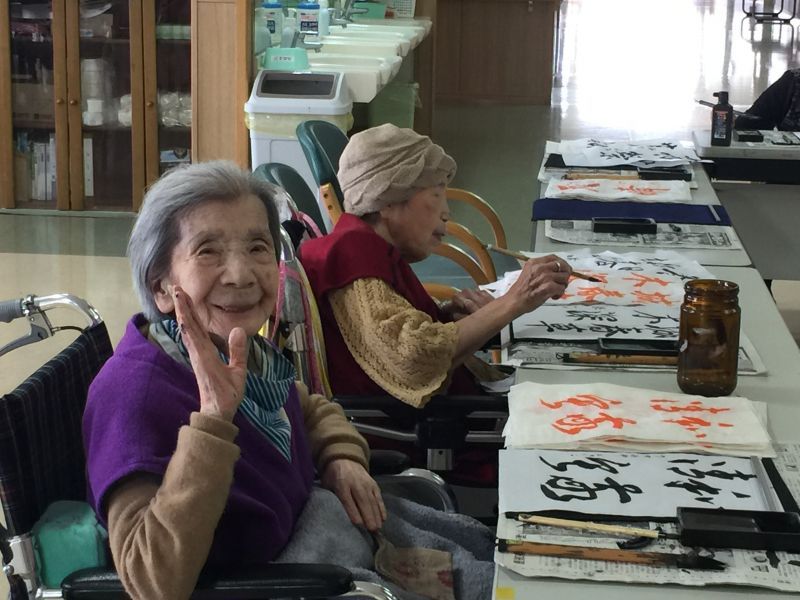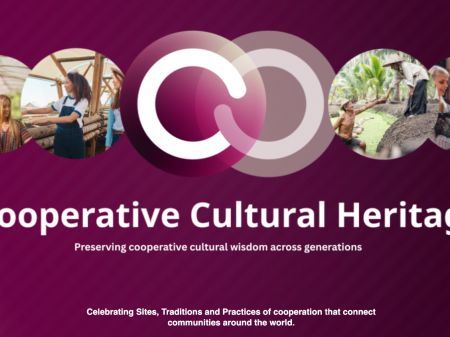
The Meiji Shrine in Tokyo, dedicated to Emperor Meiji and Empress Shoken, located in a 200-acre park with 100,000 trees is a serene, austere, and calming place in the midst of bustling Tokyo city. At the main hall, one can toss some yen into the offering box (follow the ritual to bow head twice, clap twice, and bow once more), buy charms and amulets, and write out one's wish on an ema. Ema’s are small wooden plaques that bear various pictures of animals or Shinto imagery and often have a wish written. Earlier in the day, I had seen a similar wish wall at the Health Aging Center of the Saitama Cooperative Hospital. This one was written on paper by the septuagenarian, octogenarian and nonagenarian residents. “I wish to live a 100 years.” “I want to eat my favorite food.” “I want to be close with my family.”
I was in Saitama to get a sense of how a co-operative was addressing the issue of health care in Japan, a hyper-aging society. According to official statistics, in 2013, Japan’s population declined by a record 244,000 people. Japan's population began falling in 2004 and is now ageing faster than any other country on the planet. A report compiled by the government in 2012 predicts that by 2060 the number of Japanese will have fallen from 127 million to about 87 million, of whom almost 40% will be 65 or older. A baby girl born today in Japan can expect to live to 86 and a baby boy to 79. In Japan, it is not unusual for 70-year-olds to be driving taxis, working as watchmen on building sites and manning counters in supermarkets.
Historically, caring for the elderly rested with the family. However, with aging population, changing family structure and added economic pressures it was noticed that neglect and abuse towards older people was increasing and caring was restricting employment options for a growing number of women. Older people were admitting themselves to hospital more frequently and for long periods – not for any medical reason, but simply because they could not be looked after anywhere else. In 2000, the Japanese government introduced long-term care insurance case (LTIC), offering social care to those aged 65+ on the basis of needs alone. When people turn 40, they start contributing to LTIC, which is part insurance based and part tax-funded. On turning 65, individuals become entitled to wide-ranging social care support, from home-based help with cooking and dressing to residential respite, intermediate and permanent care. An individual's needs are assessed and they are assigned a care level which determines their entitlement.
At the Saitama Cooperative Hospital, I thought I would be given a tour of the facility and shown all the fancy, modern equipment in place. Instead, I was first taken through a presentation by two women board members, Ms. Michiko Nakajima and Ms.Etsuko Isozaki on their citizen health promotion and prevention and civil participation. “Our Kenko Hiroba activities include physical exercise in public facilities and parks, such as walking, dancing, practicing yoga, and other fitness activities. These are organized to draw citizens out of their homes and engage them. We believe prevention is better than cure.” Social exclusion is another ill which ails the elderly. “In order for our members to feel socially included we hold “Anshin Room activities” that include tea parties either in members’ houses or in public or cooperative facilities. At these parties, members take part in homemade cooking sessions, handicraft workshops, singing performances and games, etc.” The cooperative has a system where members are trained to measure and keep a record of their health statistics (blood pressure, body fat, steps walked, etc.). “This comes in handy in two ways; one it helps the individual to monitor and two provides the physician data over time.” In coordination with local government and other social organizations, Saitama combines health promotion with local community development.
Saitama Medical Co-operative is located in Saitama Prefecture, just north of Tokyo. With a population of 2.88 million people, this region is characterized as the most rapidly aging nationwide. It also has the lowest density of physicians. At the end of March 2014, Saitama had 242,098 members and 2,209 employees. The total share capital was $61 million and turnover around $189 million. Saitama Co-operative Hospital was set up in Kawaguchi City in 1978. Because of the high quality of its medical services, it enjoys a high ranking: second among 20 emergency hospitals in Kawaguchi City, and the best in the private sector. While walking around, I noticed a table where three people were seated and talking to people who stopped by. I was told these were volunteers who were getting new individuals to sign on as members. One of the volunteers was Mr. Ikazawa, who was a member of the hospital cooperative for 30 years and a volunteer at the table for 16 years. When I asked him why he was doing this, he said, “this is my passion, this is what I want to do! I feel included in my age and would like to be doing something useful. The cooperative hospital has given me my health and I would like to give back in some way.”
With the implementation of LTIC in 2000, competition was introduced between for-profit and non-profit service providers. As a consequence, the role of the state kept diminishing from that of service provider to one of financier and regulator. A fee for service system is in place where instead of restricting access, a fee schedule is used to keep prices under control. As Natasha Curry, senior fellow in health policy at the Nuffield Trust puts it. “ The oil in the machine is the care manager who holds the budget and puts together a package of care.” While the private for-profit sector has a lion’s share their focus is more on number, keeping a leash on costs and in maximizing profit. In these heavily regulated markets, cooperatives are understood to provide better access to health care, and more importantly, for the increasing number of Japanese excluded from services due to unemployment and low income.
Health cooperatives in rural areas are affiliated with the National Welfare Federation of Agricultural Co-operatives. They are secondary-level organizations owned and controlled by primary cooperatives, where individual members are the beneficiaries of health and social services provided by hospitals and clinics. Those functioning in urban areas are registered under the Consumer Co-operative Law and are owned and controlled by consumer-members. HeW Co-op Japan is a national federation of health and welfare cooperatives. The Federation comprises 111 member cooperatives and the Japanese Consumers’ Co-operative Union. Members demanded for the co-ops to undertake care services because they wished to take care of the elderly, including their own parents and relatives who needed such services. The workers’ coops were set up by middle-aged workers who wanted to secure jobs facing the discontinued government’s unemployment relief project and then took part in the provision of elderly care service. In addition, the government encouraged co-operatives to enter the welfare business because they had organized a high percentage of the female population, in both urban and rural areas, who had been expected to provide services as care workers.
In the afternoon, I had the opportunity to visit the Matsudo Local Welfare Business Place “Ajisai” (hydrangea) run by the Japanese Worker Cooperative Union (JWCU). In the absence of a legal framework for worker cooperatives, JWCU is registered under the NPO Law. The center had outsourced long-term care from the Chiba Prefecture. In addition, the center ran a job training program for people with disabilities and also helped them to live independently through a combination of medical, daily life, self-support training, and employment transfer support. Ms. Fumie Kobayashi, who manages the center had worked in various care centers but was disappointed with the treatment meted out to the residents. She told me, “Our center is unique in that people with disability who we train are employed as caregivers to the elderly. This empowers the individual and gives them the confidence to stand on their own.” Walking around the center, it was moving to see the mutual support being provided by the caregiver (person with disability) and the care receiver (elderly) to each other! We then moved to the Urayasu Local Business Place where JWCU was managing three after-schools centers outsourced from Urayasu City. This place in comparison to the earlier centers I visited was a complete contrast. It was noisy with children running around and normally formal and staid Japanese adults (70+) chasing them!
What does the future hold for long term health care and co-operatives in particular? Professor Akira Kurimoto and Ms. Yurie Kumakura touch upon this in their recent paper, “Emergence and evolution of co-operatives for elderly care in Japan .” The 2014 LTCI Act introduced the idea of integrated community care (ICC), prioritizing the coordinated care provision in communities that is targeted to be fully implemented in 2025. ICC is defined as a system that provides housing, medical care, long-term care, prevention services and livelihood support in an integrated manner in communities (it assumes an approximate range of a junior high school district). It aims to enable people to continue to live in their hometowns until the end of their lives with a sense of security once they are in severe need of long-term care. Under the gloomy forecast of a rapidly aging society and the ever-increasing competition among service providers, these co-ops are struggling to secure their position in this quasi-market. They are moving to create a model of ICC by networking diverse service providers based on original ideas of building the communities where people can live with security and dignity. They need to create a unique ICC model by combining associational and entrepreneurial aspects of co-operatives.
From my brief visit to health cooperatives and the conversations I have had, I have seen the difference co-operatives can make. Co-operatives as member-based organizations put health and well-being ahead of profits. They play a crucial role in care for the individual, prevention of illness, and social wellbeing of members and/or their dependents. Co-operatives play a key role with vulnerable populations, including the disabled, seniors, and the mentally ill and adopt an all-inclusive membership base. Even countries that boast of a youth bulge are not immune to the aging reality. A recent editorial in the Indian Express looks at rising elderly population in India ( 60-plus population jumped from 76.6 million to 103.8 million, between 2001 and 2011. This number is already close to the current population of Japan!) and describes it as a nascent industry that could turn into a veritable money-spinner just as private school education already is! Is this what we want our elderly population to be?
As we were leaving the Matsuda center, I was handed a gift made by the residents by the chirpy, active lady who had earlier served us tea. She was 76, healthy, felt inclusive, and passionately involved her work; in short HIP. Wouldn't we all like to be that in our old age? Being part of a co-operative may just be the answer.




